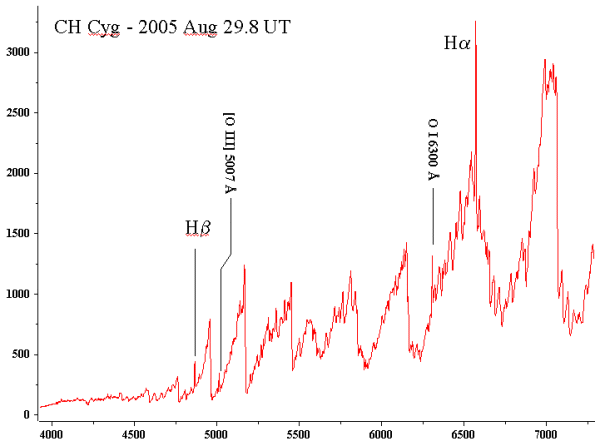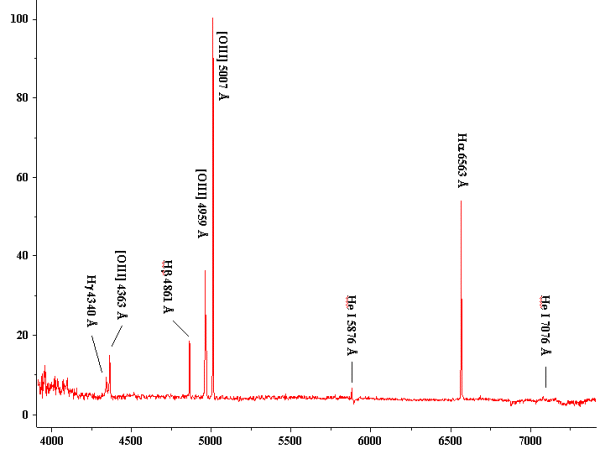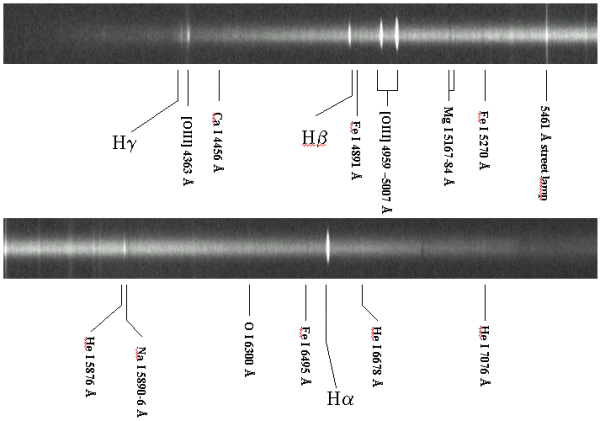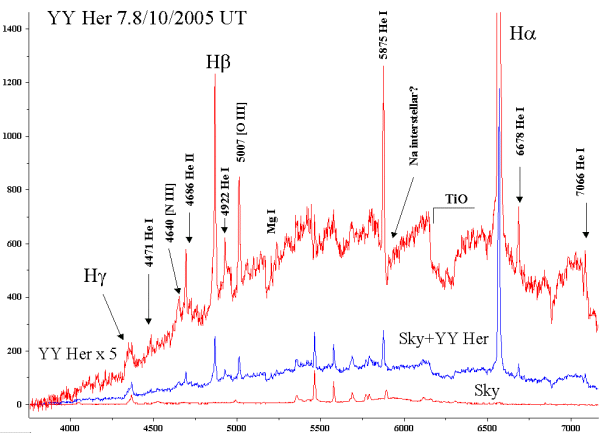Peculiar stars spectra
Symbiotic Stars Spectra
In the early years of spectral classification, most of these stars were confused with planetary nebulae. The recognition of Symbiotic stars as a class of variable stars dates from 1933 when Merrill described the spectra of AX Persei, RW Hydrae
and CI Cygni. Also the name "Symbiotic" was attributed by Merrill to these stars ten years later, to indicate the symbiosis between two
different spectra. Infact the spectrum of symbiotics shows in the same time a late tipe (G to M) continuum and absorptions (Ca I, Fe I and TiO)
and a blue continuum and high temperature emission lines (like planetary nebulae) from He, H and also forbidden transitions from [OIII]
or [NeV] or [FeVII]. During outburst, spectrum can also show an A or F continuum with He and H absorption lines because of the expanding shell
around the whithe dwarf expands and cool down from 100'000 to 10'000 K.
Today are known more than 190 of these stars. The brightest ones are: AX Per, RW Hya, AG Dra, BF Cyg, CI Cyg, CH Cyg, AG Peg, Z And and R Aqr.
Modern theories describe these objects as binary stars whose main component is an evoluted giant star orbiting together with a
white dwarf secondary. Orbital period seems to be most likely some years long.
Both stars are surrounded by gas shells that outflow the giant and are heated and ionized by the blue component. In some cases it is possible
to observe the nebula (R Aqr) surrounding the stars. Some of the gas fall into an accretion disk around the white dwarf that occasionally
produces outburst. Other causes of variability are due to rotation of the ellipsoidal shaped giant, eclipses between the accretion disk
and the giant and intrinsic variability of the giant because about 10% of symbiotic host a Mira variable. Mira itself could be classified as
symbiotic because it has a white dwarf companion named VZ Ceti.
A lot of informations on Symbiotic stars can be found in the Asiago Observatory devoted page .

|
Picture 1: A spectrum obtained on 29 aug 2005 of CH Cyg , the closest symbiotic (286 pc) that appeared as a normal M6 star prior to 1963 and then revealed
high ionisation emission lines. In our spectrum the emission lines are weak. Is this star hiding again its symbiotic nature?
5 min exposure on ST10 CCD. 60 cm telescope, 600 l/mm grating and 50 mm camera lens. Dispersion 1.7 A/pixel (spectrum not corrected
for atmospheric and instrumental spectral response).
|

|
Picture 2: StHa 190 is another example of symbiotic star but in this case the ionisation emission lines are much stronger than the continuum.
The spectrum has been recorded on 29 Aug 2005 with 15 min exposure on ST10 CCD, 60 cm telescope, 600 l/mm grating and 50 mm camera lens.
Dispersion 1.7 A/pixel. The spectrum has been corrected for atmospheric and instrumental spectral response that has been calculated
comparing the spectrum of the nearby theta Peg with an A2 V spectrum of Pickles atlas.
|

|
Picture 3: Some absorption lines can be identified in the spectrum continuum and show that the giant star is probably a G type.
|
Outburst of YY Her
Outburst of YY Her started at mid October 2005 when the star raised from mag 13.5 to mag 12.5 or even a little more. The previous outburst
occourred in 1993 and raised the star up to mag 11.5.
During outburst the material that grow up on the surface of the white dwarf start a
nuclear burning. Sometime bipolar jets appears. Nuclear burning expands the shell surrounding the white dwarf that cools down. In the spectrum
the high ionisation lines fade and the blue continuum increase.

|
Picture 4: A spectrum of YY Her recorded with 9 x 5 min exposures between 18:52 UT to 19:47 UT on Nov 7th 2005.
|
 Go Back to Peculiar Stars Home Page. Go Back to Peculiar Stars Home Page.
|
|
 Go Back to Peculiar Stars Home Page.
Go Back to Peculiar Stars Home Page.




